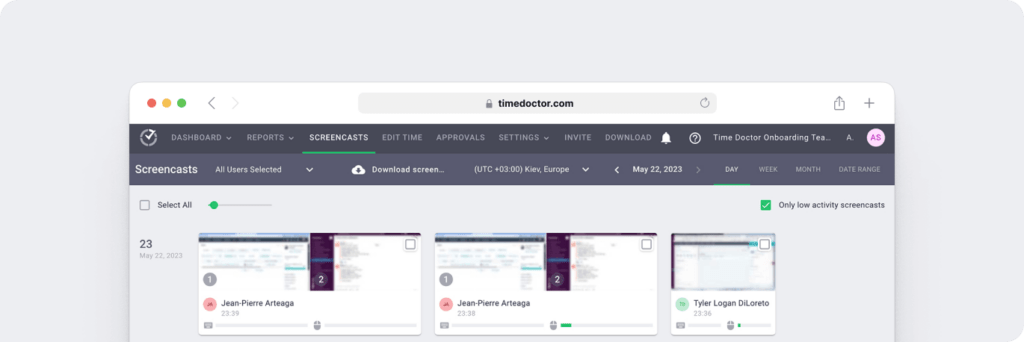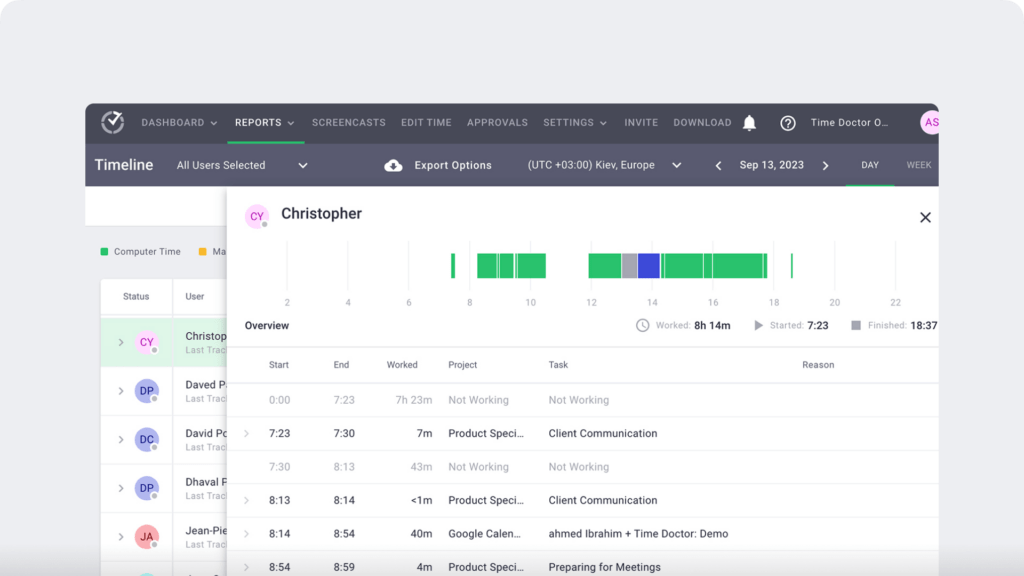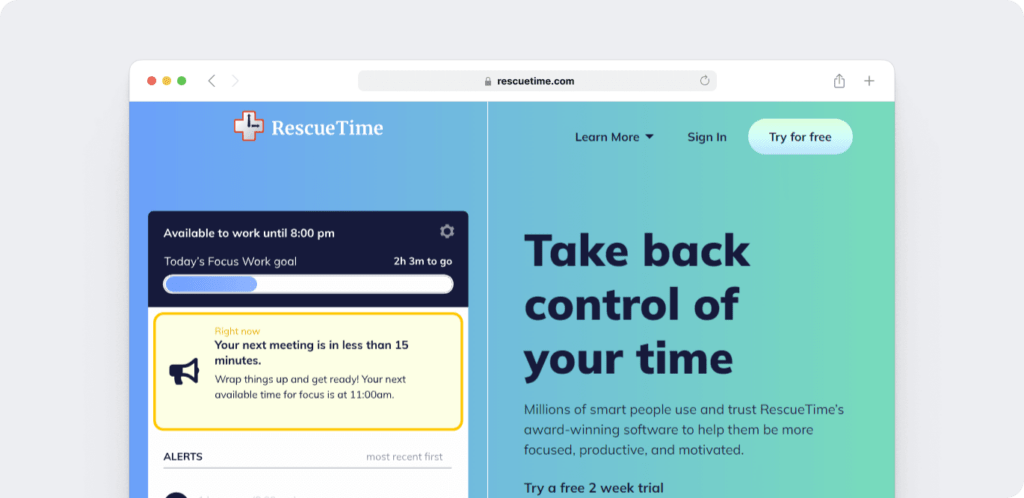If your business is still using printable timesheets, you may be missing out on payroll accuracy, productivity data, and compliance safeguards.
Every businesses lose hours of productivity and thousands of dollars in preventable payroll errors, and it often starts with one missed entry on a printable time sheet.
Let’s say, It’s payroll day. You’re sorting through a stack of handwritten time sheets. Half have missing end times, a few have smudged numbers, and one is sitting on someone’s desk at home.
Now the pay run is delayed, your billable hours are off, and you can’t give leadership a clear workforce report.
In banking, finance, and healthcare, those small gaps aren’t just frustrating. They affect payroll accuracy, compliance readiness, and the ability to spot trends in productivity or resource allocation.
Every unclear hour means a missed opportunity to forecast capacity, control labor costs, and make confident decisions.
For many organisations, printable time sheets have been a long-standing method to capture attendance and hours worked.
According to the Select Software Reviews (SSR) survey, “51% of companies still use spreadsheets for payroll, while nearly 1 in every 5 (19%) continue to rely on manual or paper processes, leaving room for inconsistencies that can impact decision-making.”
When there is uncertainty around attendance or task allocation, it becomes increasingly difficult for leaders to make confident decisions, allocate resources with precision, and achieve performance targets.
This is because tracking time goes beyond simply counting hours. Without complete and reliable data, these processes lose precision and consistency. This creates a chain reaction where priorities drift away from strategic goals, deliverables arrive later than planned, and valuable chances for improvement slip by.
In this article, we’ll share practical, editable, and printable time sheet templates, along with digital alternatives that can improve accuracy and simplify payroll.

Table of Contents
Let’s begin.
5 free printable timesheet templates (PDF, Excel & Google Sheets)
Here are 5 handy printable time sheets you can use for your business.
To use a template, click on the links to download it in your preferred format (Google Docs, Google Sheet, MS Word, PDF, or Excel format).
After you customize (if necessary) and print the timesheet template, you can start recording your staff’s hours.
Tip: The templates in the Google Sheets and Excel format include a Sample Sheet. These have built-in formulae to automatically fill in dates, end time and perform time and pay calculations. So, they double as a working Excel timesheet template.
1. Hourly timesheet template
This timesheet template allows employees and freelancers to record their tasks during each work hour. The template is designed to help you understand your staff’s daily activities.

Hourly Timesheet Download Links:
2. Daily timesheet template
This printable daily timesheet template is for recording employees’ daily tasks. It allows employees to note down time in, time out, specify tasks for hours worked, etc., on a simple timesheet.

Daily Timesheet Download Links:
3. Weekly timesheet template
This printable weekly timesheet features two daily clock-ins. It’s a weekly time card that lets employees record when they take a long break, like a lunch break. Staff members can also note their total hours and weekly pay.

Weekly Timesheet Download Links:
4. Biweekly timesheet template
The biweekly employee timesheet template works similarly to the weekly timesheet above but covers two weeks. Employees fill out the timesheet for managers to calculate pay twice a month.

Biweekly Timesheet Download Links:
5. Monthly timesheet template
This monthly timesheet follows the weekly and biweekly printable timesheet template format but includes five weeks. Employees can record their hours daily, then calculate their weekly hours and pay. Managers can then pay employees on a monthly basis.


Monthly Timesheet Download Links:
Looking to create your timesheets from scratch?
Here’s how you can make a simple timesheet template of your own.
How to create a printable timesheet (step-by-step)
Step 1 – Choose your spreadsheet tool
Start with a reliable spreadsheet platform like Microsoft Excel or Google Sheets. These give you a structured grid to easily format your timesheet and allow quick adjustments as your needs evolve.
Step 2 – Set up the basic framework
Create a clean layout that is easy to read and update. Add clear column headers and keep spacing consistent so every entry is accurate and legible.
Step 3 – Add essential fields
Include all key data points that will make the timesheet valuable for payroll, compliance, and workforce analytics, whether you are building a weekly, monthly, or semi-monthly timesheet template.
- Employee name
- Relevant dates
- Days of the week
- Month
- Time in and time out
- Total hours worked
- Projects or tasks worked on
- Percentage of tasks completed
- Additional notes for reminders or special messages
Step 4 – Format for accuracy and consistency
Use formulas where possible to calculate totals automatically. This reduces manual input time and ensures every hour is accounted for correctly.
Step 5 – Export and prepare for printing
Once the template is ready, export it to a printable format like PDF or Microsoft Word. This ensures the layout remains consistent when shared or archived.
Step 6 – Review before use
Check that every field captures the information you need for payroll accuracy, project tracking, and compliance reporting. A well-prepared template will make future record keeping smoother and more reliable.
Next, let’s explore why some businesses may choose printable time sheets, even when online timesheets are available.
How to make a printable timesheet
The best software to make a printable timesheet is a spreadsheet software like Microsoft Excel or Google Sheets. These provide a convenient grid to format your timesheet. You can then export the sheet to any other document format, such as Microsoft Word or PDF format.
Fields to consider adding to your timesheet template include:
- Employee name.
- Relevant dates.
- Days of the week.
- Month.
- Time in and time out.
- Working hour totals.
- Projects and/or tasks worked on.
- Percentage of tasks completed.
- Additional notes (to communicate any reminders or special messages).
Next, let’s explore why some businesses may choose printable time sheets.
3 key benefits of printable time sheets
Here are the 3 main reasons employers might use paper timesheets:
1. Anyone can use printable timesheets
Your less tech-savvy employees may struggle to get used to digital time tracking.
On the other hand, all your employees should be able to use a simple timesheet system to write their regular hours on paper.
2. Physical timesheets are available for records
Paper timesheets allow you to create a physical record of each employee’s work history. You can collect all their timesheets and store them in a folder for easy access.
In contrast, some digital solutions require you to pay extra to store and access historical data.
3. No onboarding or setup required
Printable time sheets don’t require any setup besides downloading and printing. This simple process doesn’t require much time or computer literacy.
However, free printable timesheets do have some drawbacks. Let’s explore those next.
Why printable timesheets are risky: 4 major drawbacks
Here are four core reasons why using a time sheet template may not be as beneficial as you think:
1. Risk of human error
Employees may occasionally make calculation errors on their timesheets. A team member could lose or forget about their sheet and fill it inaccurately later.
Inaccuracies are harder to catch on a paper time sheet template as there are no built-in checks for managers. This can cause you to pay employees incorrectly.
2. No security against time theft
Employees may purposely report false hours or tasks if they are underworking. This is called time theft.
Paper timesheets limit staff accountability. Unless you can watch your employees all day, you won’t know if they’ve filled their timesheets only for the hours they’ve worked. This, too, can lead to overpaying employees.
3. Lack of time and productivity reports
With paper timesheets, there’s no quick way to analyze employee time and productivity data to answer questions like:
- How productive are your team members?
- Are employees entertaining distractions (e.g. social media)?
- Do employees have a manageable workload?
- Are there productivity bottlenecks?
- What tasks do employees complete across each work hour?
You could perform some manual analysis, but this can be time consuming and likely won’t provide much insight. You need to analyze more than just hours worked to fully understand your staff’s time management.
4. Limits scalability
As your business and workforce or agencies grow, keeping track of paper timesheets for multiple employees may become troublesome. For example:
- Manually reviewing timesheets, making calculations, and running payroll may take a lot of time.
- You can only calculate employee overtime hours at the end of the pay period. This makes it harder to prevent excessive overtime costs.
- You can end up overspending on paper and ink, especially if you are printing a project timesheet and using a lot of storage space.
- Your business will need to maintain a separate system for tracking sick days and vacation time.
Each of these limitations will likely become more serious and costly when your team grows.
So, what’s the alternative to printable time sheets?
Let’s find out how a digital alternative to a free timesheet template could be the next logical step for your business.
Best digital time tracking software to replace printable timesheets
A digital time tracker can help you automate and streamline your employee time tracking process. Plus, they eliminate the hassle of printing timesheets.
Let’s take a look at the features, customer ratings, and pricing of three different time tracking software options:
1. Time Doctor

Time Doctor is a powerful timesheet app for time tracking and productivity management.
Time Doctor is a flexible, user-friendly alternative to a free timesheet template. You can use it as a desktop app (for Windows, macOS, and Linux), web app, and mobile app for Android. The Chrome extension also provides 60+ integrations with other apps (e.g., project management software like Asana and Trello).
Key features
Let’s take a look at some of Time Doctor’s fantastic features.
A. Interactive and silent time tracking options
Time Doctor provides two simple time tracking modes: Interactive and Silent.
The interactive mode lets employees to track time by starting and stopping a timer. The app automatically syncs time data to the employee’s digital time card when the timer is running.

The silent mode is an automated time tracking option that works in the background when a device is in use. The app generates an accurate automatic time card while employees work. This allows employees to focus on their workflow without disruption.
B. Advanced productivity management
Time Doctor offers several features to encourage and measure employee productivity.
They include:
- Idle time detection: Time Doctor detects keyboard and mouse usage to determine an employee’s activity levels. It calculates a percentage of idle time in a work hour or selected period.
- Inactivity pop-up notifications: If an employee is inactive for too long, the app displays a pop-up asking if the employee is still working. The app automatically stops the timer if the employee doesn’t interact.
- Web & app tracking: The app keeps a record of all websites and applications employees visit while the timer is on. It also assesses the productivity of each with customizable Productivity Ratings.
- Screenshots and screencasts (optional): Time Doctor can take regular screenshots and screen recordings of employee devices to ensure they are working responsibly.

C. Detailed time and productivity reports
Time Doctor can also generate comprehensive reports about time and productivity, including:
- Activity summary reports: Understand the time employees spend active, idle, or unproductive.
- Hours tracked reports: Review the total hours employees tracked in a given period.
- Web & app usage reports: See the time employees track on different websites and applications with optional Screen Monitoring to validate activity when needed.
- Attendance reports: Get an overview of employee attendance and punctuality based on work schedules you configure.
- Timeline reports: View a real-time timeline of each employee’s activity (E.g., what they’re currently working on, or what they did throughout the day).
- Custom export reports: Create custom reports to suit your business needs, downloadable in a CSV (Microsoft Excel) or PDF format.

D. Payroll integration
Time Doctor allows you to accurately track employee hours to the second, as well as set up billable rates. You can then generate and run payroll right from the app for the billable hours tracked.
The app also integrates with several payment gateways, such as PayPal, ADP, Wise, and Gusto to process payments.
You can customize the payroll in terms of:
- The pay period and currency.
- Selecting to pay an hourly rate or monthly salary.
- Paying multiple employees in bulk or paying individually.

Check out Time Doctor’s full list of features to discover what it can do for your business.
Pricing
Time Doctor offers a 14-day free trial, and no credit card is required.
Annual pricing starts at $6.70/user/month.
Basic – $6.70 (annual) / $8 (monthly)
- Automatic tracking, projects & tasks, timeline reports, screenshots, online/offline tracking.
Standard – $11.70 (annual) / $14 (monthly)
- Adds schedules, attendance, time approvals, web & app usage reports, productivity ratings, leave/break tracking, real-time alerts, and integrations.
Premium – $16.70 (annual) / $20 (monthly)
Enterprise – Custom pricing
- Adds private cloud, BI dashboards, custom contracts, guided onboarding, and professional services.
Customer ratings
- G2: 4.4/5 (414+ reviews)
- Capterra: 4.5/5 (545+ reviews)
2. RescueTime

RescueTime is an automatic timesheet software. It aims to help employees improve their time management and productivity with features like the End of Day focus review.
Key features
- Tracks employee hours and activity automatically when a device is in use.
- Provides productivity management features like Focus Sessions and distraction alerts.
- Shows your goal progress, productivity levels, and time in meetings on your Outlook or Google Calendar.
- Offers reports about hours worked, focus level, and daily activities.
Pricing
RescueTime offers a 14-day free trial. Paid plans start at $6.50/user per month.
Customer ratings
- G2: 4.1/5 (92+ reviews)
- Capterra: 4.6/5 (142+ reviews)
3. Homebase

Homebase is a great app for tracking time, managing labor costs, and facilitating team communication. It’s a good option for work environments with shifts schedules and Point of Sale (POS) systems, such as retail and hospitality.
Key features
- Allows employees to clock in and clock out and generates automatic timesheets.
- Works on a desktop, mobile device, and POS systems.
- Sends schedule change announcements and shift reminders.
- Tracks overtime hours and sends managers overtime alerts.
Pricing
Homebase offers a limited free plan for one location. Paid plans start at $99/month per 10 employees with payroll in one location.
Customer ratings
- G2: 4.2/5 (80+ reviews)
- Capterra: 4.6/5 (1,117+ reviews)
When to switch from printable to digital time tracking
1. Growing headcount
Once your team grows beyond 10–15 employees, managing paper timesheets becomes slower and more error-prone. Time Doctor automates attendance tracking, freeing HR and payroll teams to focus on higher-value tasks.
2. Increasing payroll complexity
When you introduce multiple pay rates, overtime rules, or project billing, manual calculations take more time and create greater risk. Time Doctor applies these rules instantly and produces accurate, auditable payroll reports.
3. Tighter compliance requirements
If your industry is moving toward stricter audit trails or documentation standards, digital systems like Time Doctor store secure, time-stamped records for instant retrieval during reviews.
4. Hybrid or remote teams
Distributed workforces need real-time visibility. Time Doctor updates attendance and productivity data instantly, no matter where your employees are.
5. Need for workforce analytics
If leadership is asking for insights beyond “hours worked,” Time Doctor’s workforce analytics and employee monitoring capabilities show trends in productivity, workload balance, and budget use, helping you forecast capacity and improve resource allocation.
Final thoughts
Printable time sheets can be a practical starting point for tracking hours. They are simple, accessible, and easy to implement.
However, as your team grows and your operations become more complex, you need more than a record of hours worked.
To make confident decisions, control labor costs, and forecast capacity, you need more than numbers on a page. You need real-time, accurate, and actionable workforce analytics that go beyond tracking total hours worked.
That is where Time Doctor becomes more than a time tracker. It is a complete workforce analytics platform that gives you real-time visibility into attendance, productivity trends, and budget use, enhanced by advanced tools such as Benchmarks AI for actionable performance comparisons.
You can see how work hours translate into outcomes, whether your team is in-office, hybrid, or remote, identify bottlenecks early, and align resources with strategic goals.
From automated payroll calculations to detailed productivity analytics, everything you need is available in one place.
Now ask yourself:
If you are still relying on printable time sheets, what opportunities for efficiency, cost savings, and smarter decision-making might you be leaving on the table?
Discover how Time Doctor can help you move beyond tracking hours to truly understanding how your workforce operates.
Frequently asked questions
1. Can I still use printable time sheets alongside Time Doctor?
Yes. Many businesses use printable time sheets during onboarding or as a backup. Time Doctor can digitise those records so you have both physical and digital copies for payroll accuracy, compliance reporting, and workforce analytics.
2. How does Time Doctor improve payroll accuracy compared to printable time sheets?
Time Doctor automatically records hours to the second, applies overtime rules, and integrates with payroll systems. This removes manual calculations and ensures every payment matches the actual time worked.
3. Will my team need extra training to switch from printable time sheets?
No. Time Doctor’s interface is designed to be intuitive. Most teams adapt quickly, and you can provide printable reports during the transition to make the change smoother.
4. How can Time Doctor help with compliance and audits?
With Time Doctor, every record is time-stamped and stored securely. You can pull attendance, activity, and payroll reports instantly during an audit, saving hours of manual retrieval compared to searching through stacks of paper.
5. Can Time Doctor show me more than just hours worked?
Absolutely. Time Doctor delivers workforce analytics that reveal productivity trends, workload balance, and budget allocation. This gives you actionable insights far beyond what a printable time sheet can offer.
6. What if my employees work on multiple projects in a day?
Time Doctor tracks time by project and task in real time. You can see exactly how hours are distributed across clients or deliverables, which is difficult to capture accurately on a paper time sheet.
7. Is Time Doctor cost-effective for small teams?
Yes. Even small teams benefit from accurate time tracking and automated payroll. Time Doctor eliminates hidden costs like overpayments, lost hours, and time theft, making it more cost-effective than relying on manual records.

Carlo Borja is the Content Marketing Manager of Time Doctor, a workforce analytics software for distributed teams. He is a remote work advocate, a father and an avid coffee drinker.

